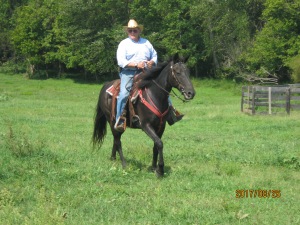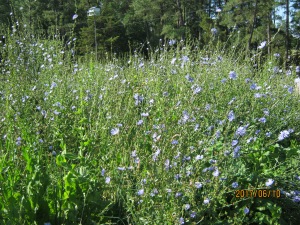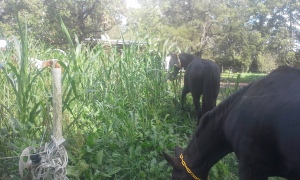Forage of the month
Chicory
As always you can click on any photo to see it larger….use your browser back button to return to the blog.
Perkins and I have both fallen in love with chicory. I began incorporating a wee little bit into my cover crop mixes about a year and a half to two years ago.
Common chicory, Cichorium intybus, is a somewhat woody, perennial herbaceous plant of the dandelion family Asteraceae, usually with bright blue flowers, rarely white or pink. Wikipedia
I added it because it is a deep rooted perennial. It has some value as a forage and can aid in building soil heath and soil tilth. The deep tap root penetrates compacted soil creating channels for water infiltration.. Since it is deep rooted, it also mines the subsoil for nutrients and brings them to the surface. When the plant is grazed the animals distribute these nutrients across the field in their waste stream.
It is a tremendous pollinator species with its abundance of bright blue morning flowers. The chicory in late spring dominated the cover crop patch on my little garden plot and it was absolutely buzzing all summer. In the late summer about a dozen gold finches discovered the plot and they were in there daily apparently feasting on the copious seed.
Since then I have discovered that it is very versatile and can be easily sown with good results most any time of year. I have frost seeded it along with clovers and Korean or Kobe lespedeza. I have put it in my cover crop mixes and broadcast it after grazing paddocks behind both horses and cattle.
Livestock love it and it is impossible to maintain under continuous grazing. The stock will graze it into oblivion. This applies to horses, cattle and goats. I would imagine other species as well but have direct experience with the three species named.
Having grazed or mown it, it is quick to rebound and put out new growth. The deep roots aid in this even in dry weather and this trait is its downfall under continuous grazing….Since it is desirable forage and rebounds quickly the livestock graze it often and hard thus contributing to its exhaustion of root reserves and eventual plant death.
However under managed rotational grazing where plants get a rest period after grazing chicory will flourish.
Chicory is classified as an introduced plant but it is found in all 48 continental states and most of the provinces of Canada. It is originally a native of the Mediterranean region. It has successfully naturalized here and can be found growing wild.
On my property I have been sowing what I believe is an improved variety. I have actually purchased chicory seed from three different sources and all of them seem to be a bit superior in forage to the native variety.
When I mow my paddocks after grazing the chicory is the first thing to put forth new growth and it very quickly has leaves 8 to 10 inches tall. At about 12 to 15 inches the woodier stems appear and the flowering begins. My purchased seed seems to yield plants that are well over six feet tall and covered in flowers.
In the cow pasture next to my home place there has been a little chicory in that field for years. It is common chicory It has always persisted but has never seemed to increase as it is in a pretty good stand of fescue and and been under the same management for 25 years..
When my neighbor died there have been a couple of different managers over the last few years and the latest manager is a practioner of rotational grazing. The chicory has shown an increased presence. Just yesterday I noticed something remarkable. Where the cows have grazed the ground pretty closely around the now stemmy chicory stems, which are still blooming, there are myriad new chicory plants coming up.. See the photo below. All the chicory needed to flourish and proliferate was an opportunity to have the grazing pressure reduced and allow the chicory to get established.
The orange circles are to illustrate the mature chicory stems.
The yellow circles are to illustrate the new chicory plants.
Below is a paddock at my place that has improved chicory. Notice the different leaf shape is more oval and smooth edged where the common chicory above is serrated and longer and thinner.
And finally below is a photo of the improved chicory which I let grow all summer. I mowed it in August.
Then I broadcast a mixture of poured up seeds leftover in small quantities. The second and third year chicory are still dominant. this is the regrowth and new seeding as of 9/16/2017.
On a non related note…..The horse folks all still think I am going to kill my horses letting them graze all manner of stuff intended for cows and goats…..Even have a new horse and she has adapted to our grazing policies….they all went into the summer cover crops beginning this past weekend….summer cover includes…pearl millet, summer cow peas, buckwheat, sorghum sudan, dwarf essex rape, sunflower, sun hemp, and okra…Condi was a little skeptical about walking thru all that tall stuff but she followed Pete who is barely visible. And Perkins loves the chicory….






